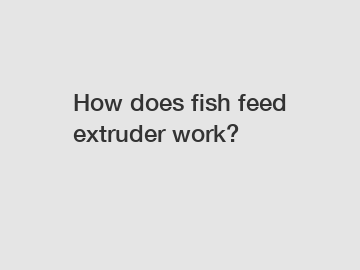How does fish feed extruder work?
How does fish feed extruder work?
Fish feed extruder is a machine used to produce fish feed pellets in the aquaculture industry. It plays a crucial role in the efficient and sustainable production of high-quality fish feed. Understanding how the fish feed extruder works is essential in optimizing the feed production process and ensuring the nutritional needs of the fish are met.
The fish feed extruder operates on the principle of mechanical shearing and pressing. The raw materials, which typically include fish meal, vegetable proteins, grains, and additives, are mixed together in a proper ratio and then fed into the extruder. Inside the extruder, the materials are subjected to high temperature, pressure, and friction generated by the rotating screws.

The screws of the extruder are designed with different sections, including the feed section, compression section, and extrusion section. As the raw materials move along the screws, they undergo various physical and chemical transformations. The feed section is responsible for conveying the materials and preheating them. In the compression section, the materials are compacted, and the moisture content is reduced. Finally, in the extrusion section, the materials are forced through the die holes, resulting in the formation of fish feed pellets.
The process of extrusion has several significant benefits for fish feed production. Firstly, it effectively destroys harmful microorganisms and parasites present in the raw materials, ensuring the safety and hygiene of the feed. Additionally, extrusion improves the digestibility of the feed, making it easier for fish to absorb nutrients. The high temperature and pressure during extrusion also contribute to the gelatinization of starches, which increases the feed's water stability and prevents it from disintegrating in water. Moreover, the extrusion process can improve the palatability of the feed, enhancing the feed intake and growth of fish.
In conclusion, the fish feed extruder functions by subjecting the raw materials to high temperature, pressure, and friction through the rotating screws. This process transforms the raw materials into fish feed pellets with improved digestibility, safety, and stability. Understanding how the fish feed extruder works allows us to optimize the production process and ensure the nutritional needs of the fish are met. It serves as a crucial tool in the aquaculture industry, contributing to the sustainable production of high-quality fish feed and the growth of the industry as a whole.
Want more information on feed mixer supplier, pelleting aids for animal feed, fine grinding hammer mills? Feel free to contact us.


